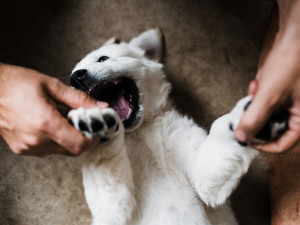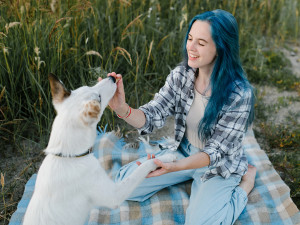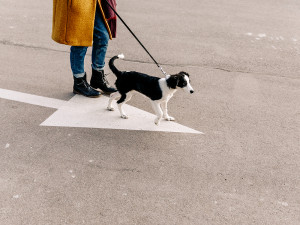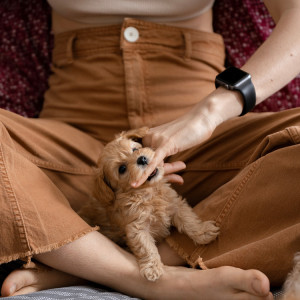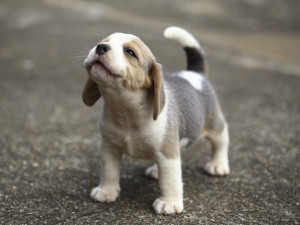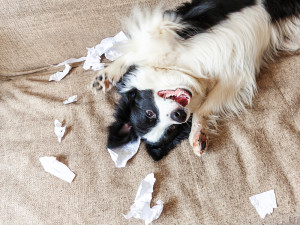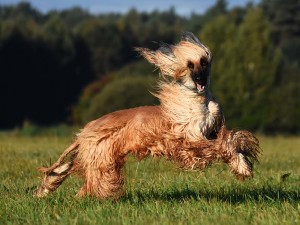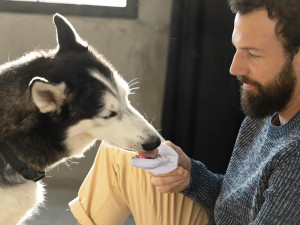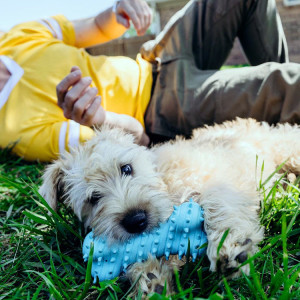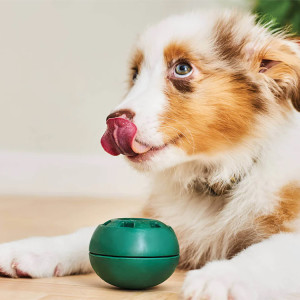Why Does My Dog Nibble on Me?
Those little teeth are sweet, but they definitely don’t feel good on your hand.
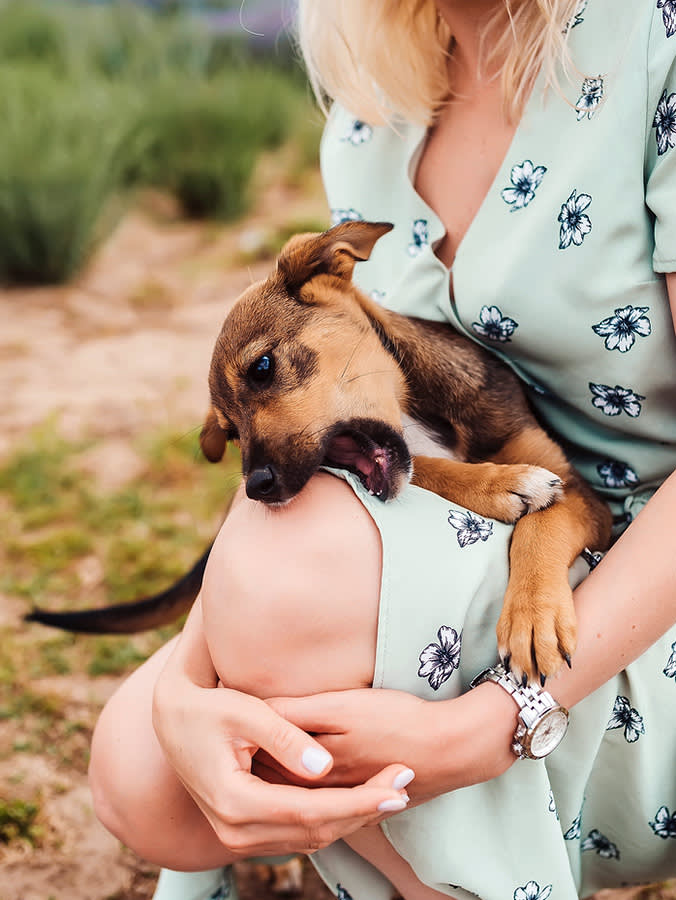
Share Article
In This Article:
Difference Between a Nibble and a Biteopens in a new tab Reasons Your Dog Nibbles on Youopens in a new tab Should I Be Concerned About My Dog’s Nibbling?opens in a new tab Recognizing Warning Signsopens in a new tab How to Stop Your Dog From Nibbling on Youopens in a new tab Frequently Asked Questionsopens in a new tab
Do you have a nibble-y little puppy? Well, that means you’re well-loved! Dogs nibble on their human parents as a sign of affection and communication learned during early socialization. It also serves as a way for dogs to explore their surroundings and learn about their role in social interactions.

littleKin™ is Kinship’s home just for puppy and kitten parents. Bop over to check out expert advice, new pet tools, and special deals—all curated for your newest family member.
opens in a new tabWhat is the difference between a nibble and a bite?
The difference between a nibble and a bite can be measured in pressure. The term “ bite inhibitionopens in a new tab” is used to discuss these differences in pressure. Basically, if it hurts, it’s a bite! This doesn’t necessarily reveal a dog’s intentions or motivations, though.
What is the difference between nibbling and mouthing?
As with the difference between nibbling and biting, nibbling and mouthing differences come down to pressure. Mouthing is considered lower pressure. Mouthing often includes holding more of the object or body part(!) in their mouths as they move their jaws.
Reasons your dog nibbles on you
1. Communication
Because dogs cannot speak with their humans, they must rely on other methods of communication. Your dog may nibble on you with their front teeth to invite playopens in a new tab, to convey a need, or to attract your attention. In any case, consider what your dog may be trying to “say” to you. Do they need water or a potty break? A “love bite” is generally preferable to a puddle of urine on the carpet.
2. Exploration
A relaxed, open mouth — including contact between teeth and skin — is one of many displays in play. Research shows that play in dogs is most commonly socially motivated. Your dog may be nibbling on you because they’re exploring the possibility of a fun play session. They’re discovering what happens with their human playmate following a nibble.
3. Development
If you’ve spent any time with a young dog or puppy, you are familiar with their desire to nibble on your hands. This is very common, because they’re using their mouths to learn more about the world around them. They’re also learning about bite inhibition, that term mentioned above. Playmates — human or dog — react strongly, often ending play when they experience a painful bite. If a puppy wants to keep playing, they need to learn to inhibit, or lower, the pressure of their bite.
4. Teething
Puppies won’t have all of their adult teeth until about seven to eight months. That means that they’ll want to soothe the aches associated with teething opens in a new tab for most of their first year of life. You can help them through this tough stage by offering them frozen chew toys and by keeping lots of chew itemsopens in a new tab available.
5. Smell or taste
Naturally, nibbling on your hand can be informative for a dog. Dogs have 100-300 million olfactory receptor cellsopens in a new tab compared to the human’s five to six million. So, nibbling, licking, and sniffing your hands or other body parts must be a lot like rewinding and watching what your friend did that day.
6. Boredom
Maybe you’ve had this experience. You’re sitting in front of the TV with your dog beside you. They start to cuddle up closer to you, becoming a little more restless. This leads to nibbling your hands or arms. When a dog isn’t sure what they should or could be doing, it’s likely that they’ll want to put their mouths on something. When you’re closest, you become the target. Have some handy optionsopens in a new tab to direct your dog’s roaming nibbles. Chews, stuffed Kongs, or toys are great alternatives to a nibble session on your hand.
Should I be concerned about my dog’s nibbling?
You should be concerned about your dog’s nibbling if it hurts you or is very frequent. It’s perfectly natural for a dog to use their mouth in both human and dog interactions. However, most dog parents would prefer that their dog communicate with them vocally or visually, not by wrapping their mouths around their parent’s hand.
Teach your puppy new methods of communication, such as ringing bells that signify they need to go out. Instead of nibbling you to say, “I really have to pee,” your dog can ring the “potty bells.”
Should I be concerned about my dog nibbling on people?
While bite inhibition, or bite pressure, is fairly stable across a dog’s adult life, fluctuations can occur depending on your dog’s stress or excitement levels. That said, it’s ideal to help your dog interact with other humans without nibbling on them.
For better or worse, dogs are creatures of routine, which also means that they’re prone to picking up habits. What you encourage or allow today is likely to influence future behavior. Instead of sitting around and letting your dog nibble on your friends, take your dog out for a walk or a game of fetch.
Recognizing warning signs
As pet parents, it’s our responsibility to become familiar with the warning signs associated with nibbling. It’s common for humans to misread playopens in a new tab versus non-play signals in dogs. It’s simply a fact that dogs have teeth, and those teeth can hurt when they’re wrapped around a finger! Become familiar with dog body language. If you’re looking for inspiration, Lili Chin has been illustrating canine body languageopens in a new tab for over 20 years. Chin recommends Brenda Aloff’s Canine Body Language to get a better understanding.
In my profession as a dog trainer who frequently educates clients on dog signals of discomfort, one of my favorite tips is to do a comparison. What does your dog look like when they’re excited to see you come home? I’m guessing you see a loose body with fluid, wave-like motions. Now, compare that to the body language in question. If you see stiff, jerky, sharp movements, be cautious.
Beyond reading your dog’s body language, consider the context. If you’re not actively engaged in play and your dog was just previously quite calm but begins growling or snarling, this is a warning sign. They may be guarding an item or space. They may be uncomfortable with a new person’s presence or movements. If any of these signs is combined with teeth on skin, or nibbling, you should consult with a qualified dog trainer or behaviorist.
Is nibbling a behavior my puppy will grow out of?
Your puppy is likely to grow out of nibbling, but remember that what you do with your dog today influences tomorrow. You can help reduce nibbling and chewing behaviorsopens in a new tab by following some basic steps.
How to stop your dog from nibbling on you
1. Provide ample and revolving dog-friendly toys.
Keep your dog interested in their toys by putting some of them away for a few weeks, then re-introducing them. If your dog is in a heavy teething phase, direct them toward toys or items to address that chewing desire.opens in a new tab
2. Mark and interrupt nibbling that hurts.
If this strategy fails, it often does because the pet parent doesn’t actually interrupt the nibbling. Once you’ve marked that painful nip with a startling sound, move away from your puppy. This might require putting a barrier or door between you and your puppy for up to 30 seconds. Your immediate absence communicates that playtime ended because a playmate was hurt.
3. Arrange opportunities for dog-to-dog play.
Puppies have their own shared language, and in the midst of play, they get hurt too. They’re masters of communicating to their puppy friends that play ends when the pain starts. Allow other dogs or puppies to educate your puppy about appropriate jaw pressure during play
4. Ditch the food bowl!
Give your puppy a challenge opens in a new tab by putting their meals into a food toyopens in a new tab. You can put your dog’s dry food into a ball or cube that spills pieces as they push it around. If you’re using a toy that holds wet food, you can still use your dry dog food by soaking it in water or in a broth, then stuffing it into a wet food toy like a Kong
5. Reinforce playtime without nibbles.
Encourage your dog to play with you while their teeth are on a tug toy or rope. This is a great way to feed their need to interact with you while meeting their nibbling needs.
When you put your dog’s brain to work, less mindless nibbling occurs. This is one of many reasons that engaging your puppy in training activitiesopens in a new tab will reduce mouthing and nipping. Teach your dog some new behavioral cuesopens in a new tab, like “spin” or “bow, ”to share a bonding moment and add to your party tricks!
FAQs (People also ask):
Are certain breeds more likely to nibble on people?
All breeds of puppies are known for their desire and need to teethe and chew. While many studies have examined the occurrence of bites and associated breeds, a common pitfall (among many) is accuracy in breed identification. For example, one study found that any “stocky, short-haired” animal involved in an attack was recorded as a “Pit Bull,” regardless of actual breed identification. This leads to harmful stereotypes of this breed type.
Should I be concerned if my dog is nibbling on themselves or another dog?
In short, yes and no. You should be concerned if your dog is regularly or compulsively nibbling on themselves. This could indicate allergies, pain, or parasites (like fleas and ticks). All of those issues require your attention and will probably involve a visit to your veterinarian. Chewing on their own body parts can also be a sign of anxiety.
If your dog is nibbling on a dog friend periodically, it’s likely not a concern. Remember, nibbling is a normal feature of dog-to-dog play.
Should you let your dog nibble on you?
You’re the one who lives with your dog. If you strongly dislike nibbles on you or other people, interrupt the nibbling. Direct your dog to activities that you find appropriate and fill their needs. Mental engagement, exercise, and affection are necessary for your dog, and you can meet all of those needs without allowing your dog to nibble on you. If they’re very persistent with those teeth, find the perfect chew toysopens in a new tab to help them out.
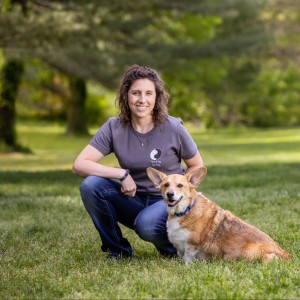
Brittany Fulton, CTC
Brittany Fulton is certified in Training and Counseling with the Academy for Dog Trainers. She owns and operates her positive reinforcement dog training business, Dances with Dogs, in the Washington, D.C. metro area. Brittany has taught behavior modification courses at Washington D.C.’s Humane Rescue Alliance.
She specializes in reactivity and fearful aggression issues.Brittany serves as chair of the Legislative Committee of the Animal Positive Coalition, striving to improve animal welfare through local regulations. Outside of her work with dogs, she enjoys cooking vegetarian meals and hiking with her husband and senior Corgi mix, Basil. Basil shares his home with his feline siblings, Nutmeg and Cannon.
Related articles
![single puppy standing outside]() opens in a new tab
opens in a new tabSingle Puppy Syndrome: One-Puppy Litter
One doesn’t have to be the loneliest number when it comes to your dog.
![Puppy laying in torn up paper on the couch]() opens in a new tab
opens in a new tabNew Puppy Driving You Nuts? Here’s How to Deal
The beginning of puppy parenthood can be rough, but it does get better — especially when you implement this advice.
![Afghan hound dog mid jump in an open grass field]() opens in a new tab
opens in a new tabOverexcited Dog? How to Calm A Dog Down
If your dog loses their sh*t over anything—from a squirrel to a guest. Here are some tips to curtail that.
![A bearded man in a gray sweater and yellow pants sitting on the floor and holding a Groov Training Aid in "lilac" from Diggs Pet, which is like a grooved plastic popsicle with treats smeared in, while his Husky dog licks it]() opens in a new tab
opens in a new tab9 Stress Toys For Dogs That Are Cheaper Than Therapy
The toys that’ll help your pup chill out after a long day of being a dog.
![a puppy chewing a chew-safe bone]() opens in a new tab
opens in a new tabThe Best Chew Bones for Puppies in 2025
Give them an alternative to your shoes.
![Mini shepherd laying on ground licking pupsicle toy]() opens in a new tab
opens in a new tabThe Pupsicle Will Soothe Puppies Who Need to (Literally) Chill
Woof’s innovative fillable design will help dogs de-stress and their parents save money.
